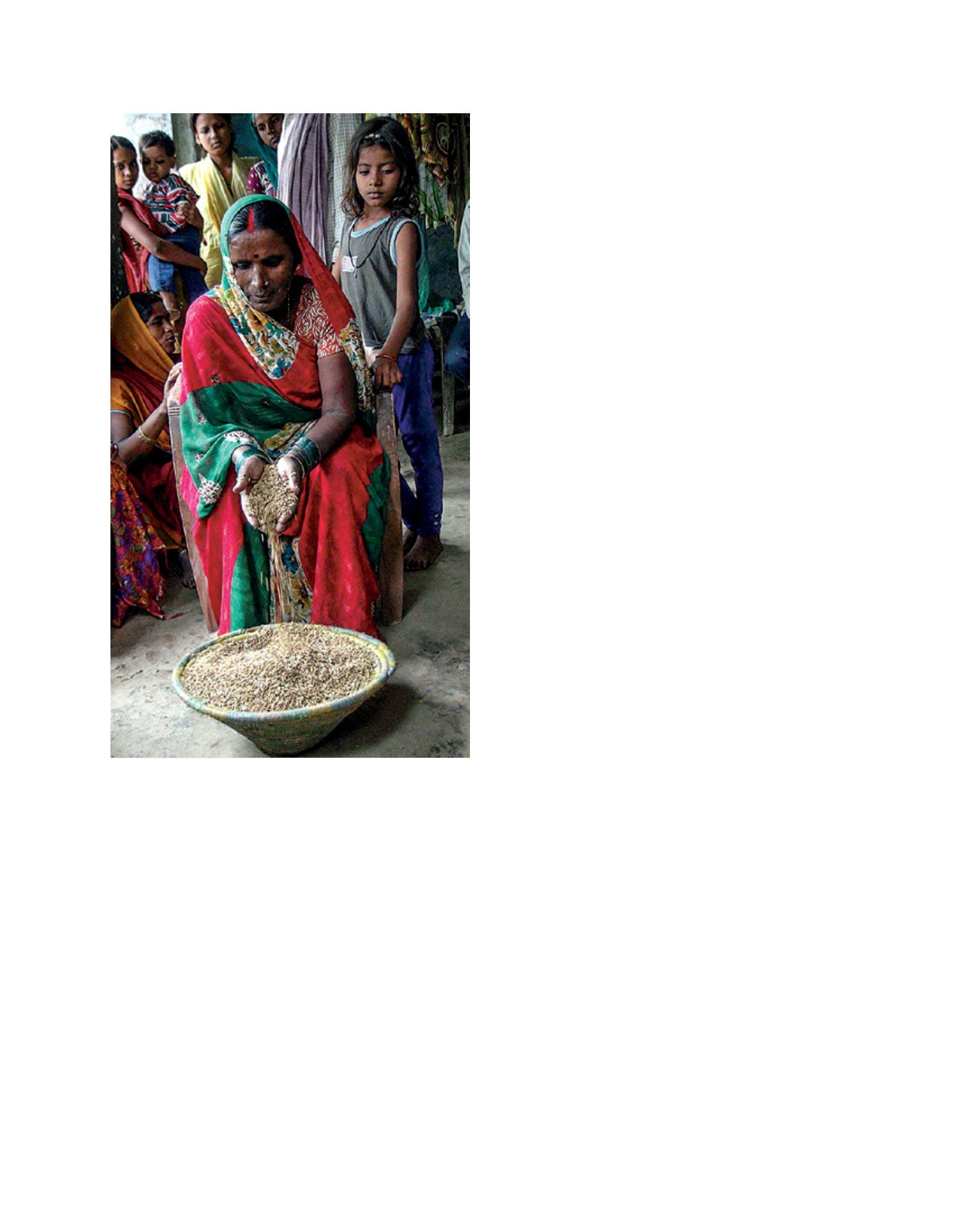

[
] 170
hinting that she has lived there for just a short time. As
I made myself comfortable on a wooden stool, I noticed a
gathering crowd of women, children and some men blocking
the natural light coming in from the door. Mrs Devi grabbed
a chair and sat in front of me. Her smile concealed her age
and the hard life she has endured.
“This year, I harvested around 22 quintals per acre of
Sahbhagi,” she said excitedly (22 quintals is equivalent to
2.2 tons and one acre is 0.4 hectares). “Over the last two
years, when planting Sahbhagi, I earned around Rs20,000
(about US$330) per acre.”
Dr Singh confirmed that the average yield of Sahbhagi
dhan is 4-5 tons per hectare when other traditional vari-
eties yield only about 2.5 tons under normal conditions.
“What is remarkable is that there is no yield penalty with
Sahbhagi dhan when a drought spell hits for 10-12 days,” Dr
Singh said. Under drought, traditional varieties often yield
nothing. And, since Sahbhagi dhan is a short-duration crop
that matures in 105 days (long-duration traditional varieties
take 120 days to mature), another bonus is that farmers can
plant three crops in a year.
Mrs Devi plants peas after rice, and then follows with
onions. She usually earns US$750 from her peas and as
much as US$580 from the onion crop. The ability of small-
holder farmers like Mrs Devi to grow other crops such as
vegetables, in addition to rice, allows them to serve a more
diverse diet to their families, thus improving the chance of
having better nutrition. For the last two years, she has also
been selling Sahbhagi seeds at about US$0.50 per kilogram
compared with US$0.25 per kilogram when sold as grains.
This gives her an extra US$250 per ton of rice.
While a traditional variety such as Sarju55 requires four
irrigations, Sahbhagi dhan requires only two. Farmers can
save up to two irrigations; each irrigation usually has an
energy cost of US$30. Therefore, farmers planting Sahbhagi
dhan can save US$60 per crop.
The strong-spirited Mrs Devi is known in the village for
having a progressive outlook. She took on the role of the family
breadwinner when her husband was stricken with hypertension
and a heart problem, making him unable to work.
“God has blessed me with four cows, so no worries,” she
said with an air of cheerfulness that had never left her face
since I met her two hours before. Cows are considered ‘help-
meets’ in rural India as they provide milk, a source of protein
for the family. Mrs Devi sells some extra milk to her neigh-
bours. A cow can assure additional income of about US$3 a
day. Cows will continue to give milk for several months as
long as they are healthy and well-fed. This is why Sahbhagi
dhan straw is very important to most farming households.
“Four of my five daughters are married,” Mrs Devi proudly
related. In her village, a married daughter implies that a
household has a healthy financial status because the cost of
the dowry can range from US$400 to more than US$800 –
an amount that is difficult to come by for ordinary farmers.
“My life is now easier as I have only one daughter left to
marry,” she said. After that day comes, Mrs Devi dreams of
enhancing her ‘oasis’ by purchasing a new house and maybe
even a new car. She already owns a second-hand white van
that she rents out as a public utility vehicle.
When a young man in his early twenties approached Mrs
Devi, she proudly introduced him as her son, who graduated
from a three-year college course and now works in Bombay.
Mrs Devi has become an inspiration to other women in
Nagwa. She has been able to save US$800 through a self-help
group for women. This amount was added to the self-help
group’s capital that is available for loans to members at very
low interest rates. They can use the money for household or
farm-related needs.
At the end of each year, the members distribute the divi-
dends among themselves. One woman farmer bought a pair
of earrings with the dividend she got. “This speaks a lot
about these women,” Dr Paris later pointed out. “The money
they’ve earned themselves can now be used in any way they
want. To them, jewellery is a valuable asset they can claim as
their own. They can sell it, use it as collateral for more loans
or give it as a gift for a daughter’s dowry. This is empower-
ment in plain clothes.”
Village-based self-help groups provide farming families with low-interest
loans, dividend payments, and access to climate-smart rice seeds
Image: IRRI
D
eep
R
oots
















